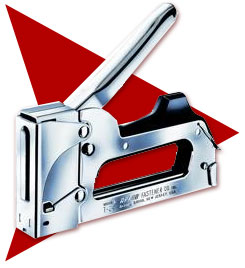
You'll need a special stapler to use Arrow fasteners and staples since they're a bit larger than those that fit into the stapler on your desk. There are two basic types of industrial staplers – slap staplers and standard ones. The slap variety are used by simply slapping the stapler against a surface and aren't really used for installing cables or wires since they lack any real finesse – they're better used to install fiberglass insulation, roof felt, and house wrap. Standard industrial staplers have a base and a handle. You squeeze the handle towards the base to fire off a staple. These are preferred when installing cables and wires since you can position them in such a way that the sharp points will miss the cable and the flat section will form a bridge over it, holding it in place.
Arrow fasteners and staples come in a variety of sizes and lengths. The clips of staples themselves are similar to those you're used to seeing in an office stapler and are simply strips of staples connected by a thin strip of clue. They're also loaded in a similar manner. But industrial staples are much heavier in thickness and length. The lengths of these staples usually range from three eights of an inch up to an inch. Obviously the longer sizes will hold better but depending upon the material they're firing into they may not sink all the way. Most staplers won't be able to sink a one inch staple completely into wood, for example. The exact size of staple that you'll need will depend upon the type of material you're stapling into and what you're using them for. Half inch staples or even three eights of an inch staples are usually the best options for installing cable and wire since they'll allow you to get decent penetration without harming the wire. This may vary if you're installing very thick or very thin wire, however.

Some Arrow fastener staples may be insulated to help protect the cable from being crushed or damaged, and are often the preferred choice for those installing cables. Once you've selected the right ones, installation is a simple matter. It doesn't take a huge amount of staples to install a run of cable and in most cases a staple is placed every two feet or so, with an additional one being used anywhere the cable turns a corner. If you're planning on installing cables you'll likely need to invest in a stapler and some high quality staples to ensure that your efforts stay where you want them to.
No comments:
Post a Comment